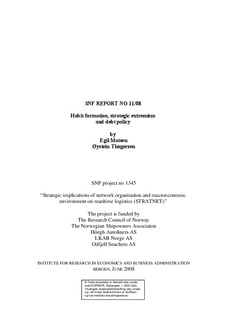| dc.contributor.author | Matsen, Egil | |
| dc.contributor.author | Thøgersen, Øystein | |
| dc.date.accessioned | 2008-10-21T12:57:38Z | |
| dc.date.available | 2008-10-21T12:57:38Z | |
| dc.date.issued | 2008-06 | |
| dc.identifier.isbn | 978-82-491-0577-9 (elektronisk versjon) | |
| dc.identifier.isbn | 978-82-491-0576-2 (trykt versjon) | |
| dc.identifier.issn | 0803-4036 | |
| dc.identifier.uri | http://hdl.handle.net/11250/165301 | |
| dc.description.abstract | We suggest a probabilistic voting model where voters’ preferences for alternative public goods display habit formation. Current policies determine habit levels and in turn the future preferences of the voters. This allows the incumbent to act strategically in order to influence the probability of re-election. Comparing to a benchmark case of a certain re-election, we demonstrate that the incumbent’s optimal policy features both a more polarized allocation between the alternative public goods and a debt bias. | en |
| dc.language.iso | eng | en |
| dc.publisher | SNF | en |
| dc.relation.ispartofseries | Report | en |
| dc.relation.ispartofseries | 2008:11 | en |
| dc.title | Habit formation, strategic extremism and debt policy | en |
| dc.type | Research report | en |
| dc.subject.nsi | VDP::Samfunnsvitenskap: 200::Økonomi: 210::Samfunnsøkonomi: 212 | en |
